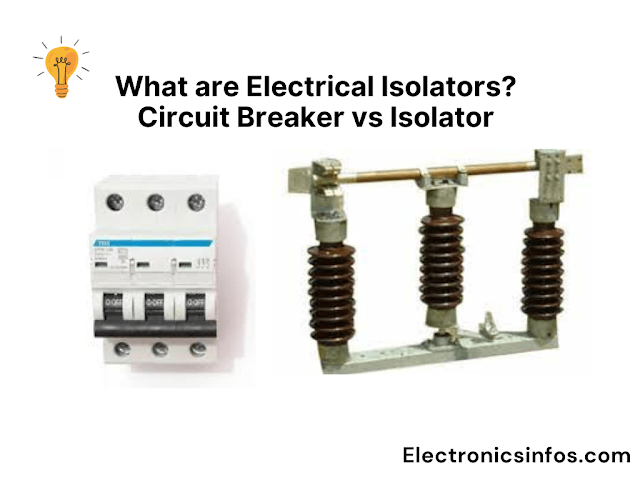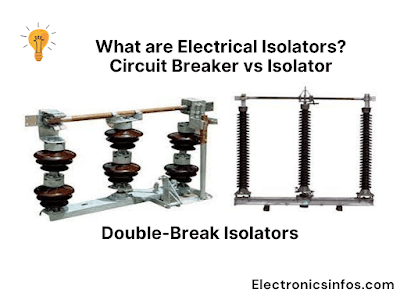What are Electrical Isolators?
 |
| What are Electrical Isolators? |
Electrical isolators, also known as electrical disconnect switches.it is used to provide electrical separation between a circuit to its power source.
The main function of electrical isolators is to interrupt the flow of current in a circuit. Isolators are installed in series with other protective devices such as circuit breakers or fuses to provide a complete isolation. When an electrical isolator is opened, it breaks the electrical circuit.
Types Of Isolators
There are several types of isolators used in electrical systems including
- Verticle break-type isolators
- Knife-Blade Isolators
- Pantograph Isolators
- Centre-Break Isolators
- Double-Break Isolators
- Semi-pantograph Isolators
Vertical-Break Isolators
Vertical-break isolators are used in extra-high voltage transmission systems. They feature vertically oriented blades that move up and down to interrupt the circuit. Vertical-break isolators are designed to handle high currents and provide reliable operation.

Applications of Vertical Break Isolators
- Vertical break isolator used in high-voltage transmission lines for maintenance.
- it is Used to isolate faulty sections in distribution networks.
- it is used to isolate sections of railway electrification systems.
- it is used in large HVAC systems to isolate electrical components.
- Vertical break isolators are Used to disconnect equipment like transformers and circuit breakers for maintenance in electrical substations.
Knife-Blade Isolators
Knife blade isolators are the most basic isolators. They consist of a pivoting knife blade that can be manually opened or closed to interrupt the electrical circuit. Knife-blade isolators are used for low-voltage applications.
 |
| What are Electrical Isolators? |
Applications of Knife Blade Isolator
- Knife-blade isolators are used in low-voltage distribution panels to isolate circuits.
- They are used in laboratory setups to provide a manual disconnect option for electrical equipment.
- Knife-blade isolators are used in educational settings, such as classrooms or training experiments.
- knife switches can be used to disconnect temporary power connections safely in construction sites.
Pantograph Isolators
Pantograph isolators, also known as gang-operated switches, are designed for medium to high-voltage applications. They consist of multiple blades that move in a scissor-like motion to establish or break the electrical connection. Pantograph isolators are often used in substations and transmission lines.

Applications of Pantograph Isolator
- Pantograph isolator Used to disconnect overhead catenary wires from trains' pantographs during maintenance.
- In case of faults, Pantograph isolators are used to Isolate equipment for maintenance.
- it is used to Isolate components like inverters or transformers during maintenance.
Centre-Break Isolators
Centre-break isolators are commonly used in medium to high-voltage systems. They have a central rotating post with two sets of contacts on either side. When opened, the contacts move away from each other, creating a visible air gap. Centre-break isolators are typically motorized for remote operation.
 |
| What are Electrical Isolators? |
Applications of Centre-Break Isolator
- The centre break isolator completely de-energized the circuit for safe maintenance work.
- It is commonly installed in substations to isolate transformers, circuit breakers, and other equipment.
- it is designed to open an electrical circuit when no current flows.
- In industrial settings, they provide a means to safely disconnect power for machinery and equipment during repairs or inspections.
- it is Utilized within power distribution networks to isolate sections of the system.
- It can be operated manually and automatically.
Double-Break Isolators
Double-break isolators are similar to the centre-break isolator. They have two rotating posts with sets of contacts. it provides an additional breaking point. These isolators have improved performance at current interruption and are often used in high-voltage applications.

Applications of Double-Break Isolator
- Double-break isolators disconnect high-voltage transmission lines from the main grid.
- In substations, double-break isolators isolate equipment such as transformers, circuit breakers, and busbars.
- Power plants use double-break isolators to isolate generators, transformers, and other critical equipment from the grid.
- double-break isolators to isolate machinery and electrical installations for maintenance.
- Double-break isolators are used in switchyards to isolate sections of the electrical network.
- In railway electrification systems, double-break isolators are used to isolate sections of the overhead contact system.
Semi-pantograph Isolators
Semi-pantograph isolators combine the characteristics of knife-blade isolators and pantograph isolators. They are commonly used in medium voltage applications and provide a compact and reliable solution for isolation.
 |
| What are Electrical Isolators? |
Applications of Semi-Pantograph Isolator
- Semi-pantograph isolators disconnect high-voltage transmission lines.
- semi-pantograph isolators isolate generators, transformers from substation.
- Semi-pantograph isolators are used in switchyards to isolate sections.
- Semi-pantograph isolators are installed on overhead power lines.
- Semi-pantograph isolators are used in switchgear assemblies to isolate electrical equipment.
Circuit Breaker vs Isolator
Circuit breakers and isolators are important components of electrical systems but serve different functions. Here's a comparison between circuit breakers and isolators
Circuit Breaker
- A circuit breaker protects electrical circuits from overloads, short circuits, and faults.
- It automatically detects abnormal current conditions and interrupts the circuit to prevent damage to the equipment.
- Circuit breakers have built-in mechanisms that can trip or open the circuit.
- They can be either thermal, magnetic, or a combination of both.
- Circuit breakers provide both overload protection and short circuit protection.
Isolator (Disconnect Switch)
- An isolator, also known as a disconnect switch, is used for electrical isolation and physical disconnection of a circuit from the power source.
- Its main purpose is to ensure that a circuit or equipment can be safely de-energized and isolated for maintenance.
- Isolators are manually operated switches that are opened or closed to establish or break the electrical connection.
- Isolators are not designed for interrupting high fault currents like circuit breakers.
Conclusion
Electrical isolators and circuit breakers are important components in the safety and operation of power systems. Isolators are used to ensure that a circuit is completely de-energized.
circuit breakers are designed to protect circuits from overloads or short circuits by interrupting the current flow. Both devices are essential for the safety of electrical systems.
Frequently Asked Questions – FAQs
What are Electrical Isolators?
Electrical isolators are mechanical switches.it is used to disconnect the power supply from a system.
What is the difference between a Circuit Breaker and an Isolator?
Circuit breakers are automatic devices designed to protect circuits from overload or short circuits. On the other hand, Isolators are manual devices used to be completely de-energized for maintenance.
When should an Isolator be used?
Isolators should be used during maintenance or when a part of the electrical system needs to be safely disconnected without affecting the rest of the system.
Can Isolators and Circuit Breakers be used interchangeably?
No, they serve different purposes.
What safety precautions should be taken when using an Isolator?
Always ensure that the isolator is in the off position before beginning any maintenance work, and verify that no current is flowing through the circuit.

.png)



0 Comments
please do not insert spam links